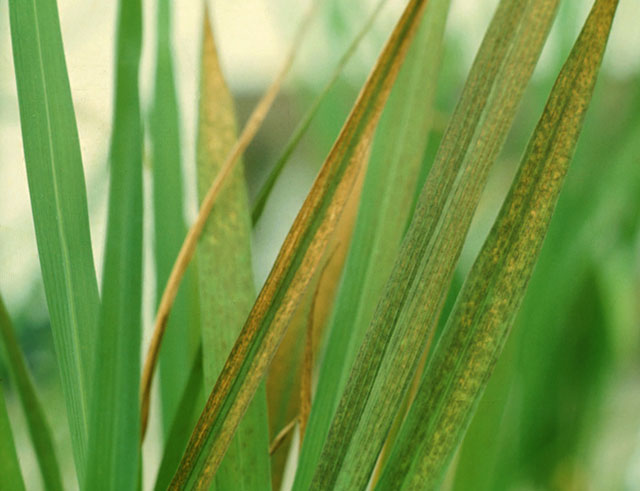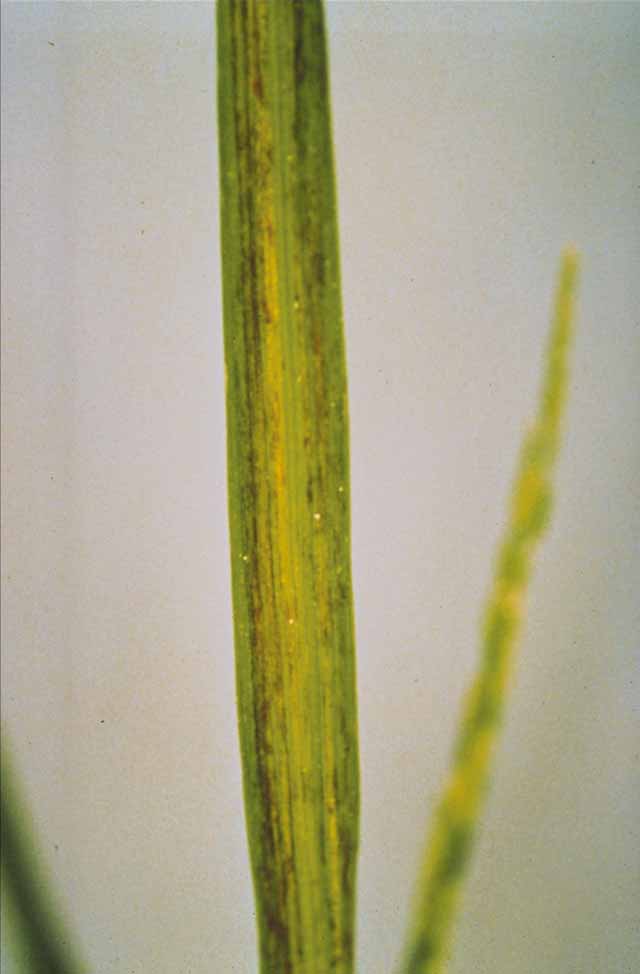Iron (Fe) toxicity
What it does

Iron (Fe) toxicity leads to increased polyphenol oxidase activity, leading to the production of oxidized polyphenols. It also causes leaf bronzing and reduced root oxidation power.
Why and where it occurs
Fe toxicity occurs on a wide range of soils, but generally in lowland rice soils with permanent flooding during crop growth.
It can happen throughout the growth cycle of the crop.
How to identify
 Check plants for the following symptoms:
Check plants for the following symptoms:
- tiny brown spots on lower leaves starting from tip and spread toward the leaf base or whole leaf colored orange-yellow to brown
- spots combine on leaf interveins and leaves turn orange-brown and die
- leaves narrow but often remain green
- in some varieties, leaf tips become orange-yellow and dry up
- leaves appear purple-brown if Fe toxicity is severe
- stunted growth, extremely limited tillering
- coarse, sparse, damaged root system with a dark brown to black coating on the root surface and many dead roots
- freshly uprooted rice hills often have poor root systems with many black roots
To confirm iron toxicity, send soil and plant sample to lab for Fe toxicity test.
Why is it important
Fe toxicity can affect the rice crop throughout its growth cycle.
How to manage
To prevent iron toxicity:
- Plant tolerant varieties.
Contact your local agriculture office for an up-to-date list of available varieties. - In temperate climates where direct seeding is practiced, coat seeds with oxidants (e.g., Ca peroxide at 50−100% of seed weight)
- Delay planting until the peak in Fe2+ concentration has passed (i.e., not less than 10−20 d after flooding)
- Use intermittent irrigation and avoid continuous flooding on poorly drained soils containing a large concentration of Fe and organic matter
- Carry out dry tillage after the rice harvest to enhance Fe oxidation during the fallow period, but this will require machinery (tractor)
To control:
- Balance the use of fertilizers (NPK or NPK + lime)
- Apply sufficient Potassium (K) fertilizer
- Apply lime on acid soils, do not apply excessive amounts of organic matter (manure, straw) on soils containing large amounts of Fe and organic matter and where drainage is poor
- Use urea (less acidifying) instead of ammonium sulfate (more acidifying)
There is currently no practical field management option to treat iron toxicity. Where possible,
- Apply additional K, Phosphorus, and Magnesium fertilizers
- Incorporate lime in the topsoil to raise pH in acid soils
- Incorporate about 100−200 kg MnO2 ha-1 in the topsoil to decrease Fe3+ reduction
- Carry out midseason drainage to remove accumulated Fe2+, at the midtillering stage (25−30 days after planting/sowing)
- Drain the field and keep it free of floodwater (but moist) for about 7−10 days to improve oxygen supply during tillering







